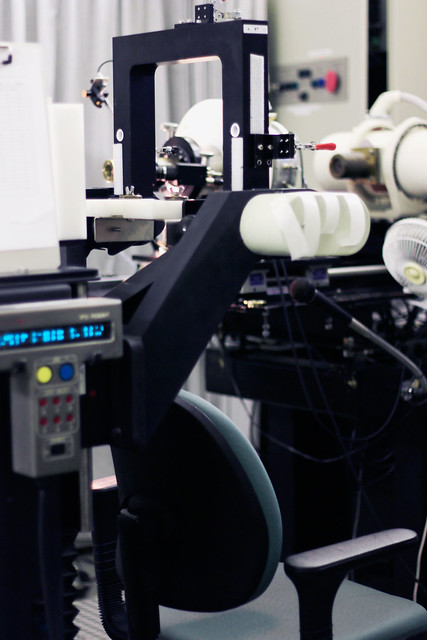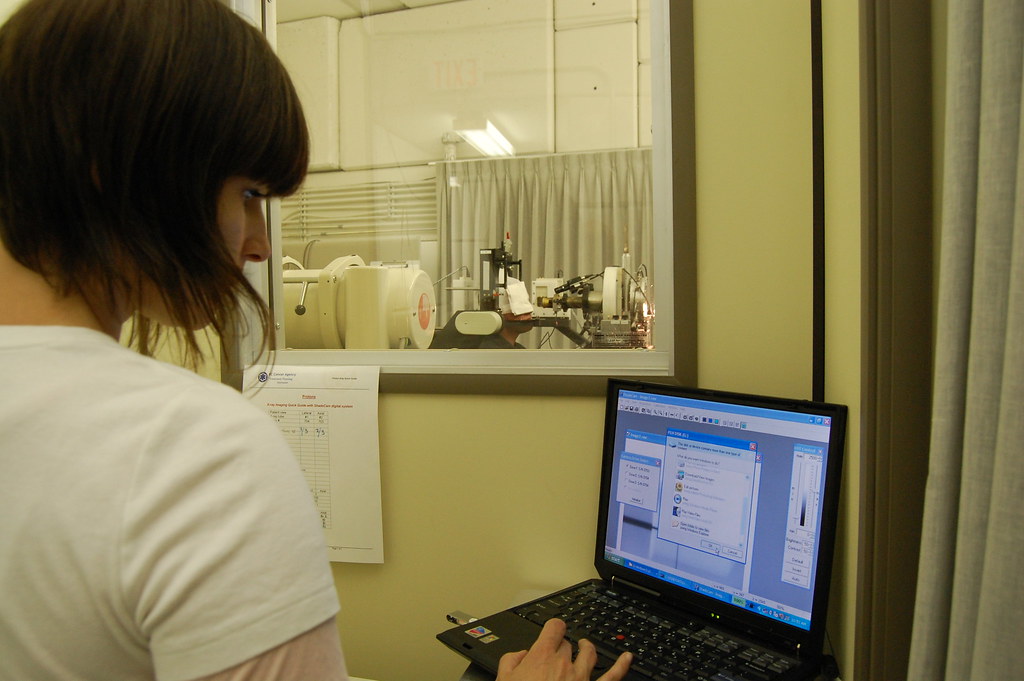Read the complementary press release here.
In a wood-paneled office, surrounded by filing cabinets that are overflowing with timeworn papers, Dr. Ewart Blackmore sits in front of his desk, leafing through a package that he’s put together. The faded security badge on his hip is just another clue that Blackmore has been at TRIUMF for a long time. “Longer than almost anyone,” he jokes.
While he was a postdoctoral researcher in England in 1967, the framework for TRIUMF was being established. Blackmore had no plans to return to the University of British Columbia, where he earned his PhD degree in nuclear physics. However, he was invited back by his former supervisor to take part in something big. His supervisor’s name was Dr. John Warren – TRIUMF’s first director.
Dr. Ewart Blackmore has been here ever since.
Having held multiple positions during his time at TRIUMF, Blackmore has had the opportunity to watch the lab grow. His longstanding interest in “looking for practical applications for proton beams” acted as one of his overriding duties, motivating his work until the day that he retired (although today he continues his work at TRIUMF as an emeritus.)
One such interest for Blackmore led to the establishment of TRIUMF’s proton therapy centre for cancer treatment, which is celebrating its 20th anniversary on Aug 21, 2015.
The centre uses protons from TRIUMF’s main cyclotron to irradiate cancerous tumors with high precision, thus destroying the tumor while leaving the surrounding tissue unharmed.
As the only one of its kind in Canada, TRIUMF’s proton therapy centre fills a gap in treatment options for ocular melanoma, a cancer of the eye. “The cancer itself is very rare, but if it’s left untreated, it’s lethal,” says Proton Therapy Manager Dr. Conny Hoehr.
Like other types of cancers, there is also the risk that the tumor may spread to and attack other organs. In the case of ocular melanoma, there is a pattern of the tumor spreading to the liver, which is challenging to treat. Quick and effective treatment is essential and proton therapy might be a patient’s best bet.
It was for Kim Wright.
A routine eye exam in February of 2009 resulted in a surprising diagnosis.
“I didn’t even know you could have eye cancer,” exclaimed Wright, recalling the moment six years ago when she learned that a small freckle on her retina had grown to something much bigger.
An aggressive, large tumor (at 5.2mm high and 14mm long) left the 46-year-old single mother in “unbelievable shock,” with thoughts of the worst-case scenario running through her mind.
“Your life totally changes, like I’m sure every cancer patient will say,” explained Wright. “All of a sudden, my normal life turned into waiting for CT scans, waiting for MRIs.”
“The tumor is fairly obvious when you look in a patient’s eye with the right instruments,” said Blackmore of the initial diagnosis, “because this melanoma is a different colour than the rest of the eye.” But before treatment can begin, extensive medical imaging is required to assure that the cancer has not begun to spread, which would change the course of action.
Historically, ocular melanomas were treated with the removal of the eye – thus removing the tumor entirely. While this may still be an option in extreme cases, University of British Columbia (UBC) Ophthalmologist Dr. Katherine Paton aims to preserve quality of life.
“The whole program starts with her,” says Hoehr about Dr. Paton’s involvement in proton therapy. “Patients are referred to Katherine from all over Canada or even internationally. She looks [at the tumor] and diagnoses if it’s a case for proton therapy.” In some cases, Dr. Paton will treat the tumors with another radiation technique called brachytherapy.
Essentially, Hoehr elaborated, “We are getting the worse cases: if the tumor is really large or if it’s next to another sensitive organ.” The precision of the proton beam ensures that only the tumor and immediate-surrounding tissue will receive radiation.
Unlike X-rays that will continue to deposit radiation past the tumor, the proton beam can be calibrated so the irradiation will stop at the point of the tumor. This is crucial because of the eyes’ proximity to the brain.
Understanding the nature of such an aggressive tumor, Wright’s ophthalmologist pointed her in Dr. Paton’s direction. Within three months of the initial diagnosis, she made the 4,360-kilometer journey from her home in Ottawa to TRIUMF in Vancouver for the treatment.
Proton therapy centres are rare due to the expenses needed to build and operate them.
“TRIUMF kind of cheated,” Hoehr jokes. The majority of the infrastructure needed for such a facility was already in place. “You need a large cyclotron! It’s really expensive to get a facility like this.”
A powerful cyclotron is essential to ensure the proton beam goes through whatever tissue is in font of the tumor. “The depth into tissue – so how far you can reach with the protons – is only defined by the energy,” describes Hoehr. “If you want to go three centimeters into the tissue, you need about 70 MeV. If you want to go 20 to 25 centimeters, you need about 230 MeV. To be flexible, you need protons with an energy of at least 230 MeV,” she explained. TRIUMF’s main cyclotron can deliver beam up to 500 MeV.
In addition to already having the cyclotron, the 70-120 MeV beam line had previously been developed for isotope production. The majority of the treatment facilities, including the waiting room, the extension of the beam line into the treatment area and the patient treatment chair were financed by a grant from the Woodward’s Foundation.

TRIUMF and the British Columbia Cancer Agency (BCCA), with Blackmore’s assistance from Cyclotron Operations, were involved in an experiment with a different type of novel radiotherapy in the 1980’s: pion therapy.
The concept was similar; use pions from the main cyclotron to irradiate tumors with high precision. They hoped to answer the question: “Would pions, which deliver a dose of heavily ionized particles, be more effective at treating brain tumors that are immune to treatment with conventional therapy?”
“There were about 300 patients treated with pions,” recounted Blackmore. While this number is impressive, the treatment proved to be not as effective as the researchers had anticipated. Unfortunately, patient survival rates after five years did not differ tremendously from those of patients who had undergone conventional treatments.
As well, this treatment required a lot of resources – namely, beam time.
“It was very difficult to do because [pion therapy] was a 15-fraction treatment, meaning the patient had to come everyday for 15 days,” explained Blackmore. “They had to have the machine running for 15 days.” Proton therapy, on the other hand, only requires four days of beam at a time at low beam current.
Blackmore was an early advocate for TRIUMF’s proton therapy program. “While we were doing pion therapy in the 80s, I kept telling the people that it would be a lot easier to do cancer therapy with protons,” he said.
With the aid of Dr. George Goodman of the BCCA, he succeeded at establishing a collaborative team that is still responsible for running the treatments today.
Dr. Roy Ma and Dr. Tom Pickles, oncologists from the BCCA, join Dr. Paton. There is also a team of medical physicists who put together a treatment plan as well as technicians who take X-rays to align the eye correctly. “When we are treating, there are a lot of people downstairs,” said Hoehr. “It’s labor intensive to do a treatment like that."
Their expertise comes across during the four days of intense work. Wright thought back to her first time sitting in the treatment chair: “They really put my mind at ease and I felt very comfortable that they were so knowledgeable.”
This comfort is essential as the patient must sit perfectly still during the 90-second bursts of radiation. A set up that takes anywhere from 30 minutes to two hours assures that the beam is aimed at the tumor, not at the healthy tissue.
“There’s a flashing light that I had to look at,” Wright explains. “I didn’t feel the beam. I just had to look straight on and not have my eye stray off of that light.”
Wright’s treatment went as planned and she is now included in the 85 per cent of ocular melanoma patients who have survived past the five year mark – a typical success marker of cancer treatments. “Oh my goodness, I am such a success story!” Wright laughs. “Everything happened the way [Dr. Paton] thought it would happen, so now it’s just managing the side effects.”
Proton therapy treatment for ocular melanoma has an incredibly high success rate, compared to other cancers. For example, the Canadian Cancer Society estimates that approximately only 61 per cent of colorectal cancer patients – one of the four most common cancers in the country – will survive five years post-treatments.
Its time-tested success isn’t stopping TRIUMF’s proton therapy team from trying to increase the treatment’s precision.
Over the twenty years of success, the proton therapy program continues to refine its techniques and acts as a unique interdisciplinary training ground for young researchers. Under the direction of Dr. Conny Hoehr, a new student-led experiment is making use of 3D printing technology to test the accuracy of the team’s method of controlling the proton beam.
University of Victoria graduate student Clay Lindsay has developed a system for irradiating a 3D printed model eye, known as a phantom, to check the accuracy of the beam and proton therapy treatment plans
UBC Engineering Physics co-op student Nick Unick constructed the phantom using the digital modeling software SolidWorks. The phantom, although plastic, was modeled with extreme accuracy, down to the optic nerve and protruding cornea. Chelsea Dunning, a UBC summer student at TRIUMF, created a simulated treatment plan for the phantom, imaging a small tumor towards the front of the eye.
The team irradiated the phantom on Aug 10, in a method similar to a real treatment. The phantom was immediately delivered to the UBC hospital via a pneumatic tube to ensure that it arrived at the hospital in time to be imaged using positron emission tomography (PET). Ideally, the ionized particles should be detectable in the scan, causing the area of the phantom that was irradiated with the proton beam to be captured on the PET scan.
The scanned image will be comparable to Dunning’s digital simulation, thus enabling researchers to compare and analyze the accuracy of the beam and treatment process. Though they are still collecting data from the experiment, the team is optimistic that this will positively affect the way that patients are treated. “Of course, we always want to do better,” explained Chelsea. “These are our patients’ lives.”
“That’s what I feel TRIUMF is here for,” concluded Blackmore. Beyond the research, TRIUMF is looking towards the future of science and medicine. “We are here to educate the next generation of scientists and engineers. We should take every opportunity that we have.”
Click here for the complementary press release, or visit our Newsroom for all TRIUMF news releases.
Congratulations to all the past and present staff and students,
as well as partners from UBC and BCCA,
who have contributed to 20 years of success for the Proton Therapy program!
– Kelsey Litwin, Communications Assistant




